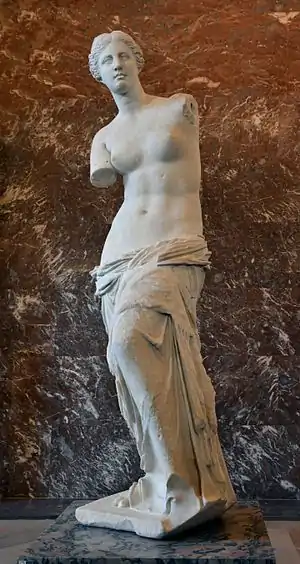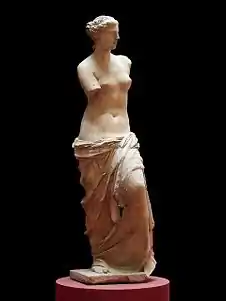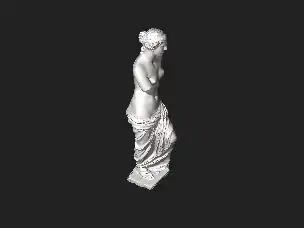Venus de Milo
The Venus de Milo (/də ˈmaɪloʊ, də ˈmiːloʊ/; Greek: Αφροδίτη της Μήλου, romanized: Afrodíti tis Mílou) is an ancient Greek statue and one of the most famous works of ancient Greek sculpture. Initially it was attributed to the sculptor Praxiteles, but based on an inscription that was on its plinth, the statue is now thought to be the work of Alexandros of Antioch.[1]
| Venus de Milo | |
|---|---|
| Greek: Αφροδίτη της Μήλου | |
 | |
| Artist | Alexandros of Antioch |
| Year | Between 130 and 100 BC |
| Type | Marble |
| Dimensions | 203 cm (80 in) |
| Condition | Arms broken off; otherwise intact |
| Location | Louvre Museum, Paris, France |
| 48.859958°N 2.337269°E | |
Created sometime between 130 and 100 BC, the statue is believed to depict Aphrodite, the Greek goddess of love and beauty, although some scholars claim it is the sea-goddess Amphitrite, venerated on Milos.[2] It is a marble sculpture, slightly larger than life size at 203 cm (6 ft 8 in) high. Part of an arm and the original plinth were lost following the statue's discovery. It is currently on permanent display at the Louvre Museum in Paris. The statue is named after Aphrodite's Roman name, Venus, and the Greek island of Milos, where it was discovered.
Description
The Venus de Milo's arms are missing, for unknown reasons.[3] There is a filled hole below her right breast that originally contained a metal tenon that would have supported the separately carved right arm. Without arms it is unclear what the statue originally looked like, but textile archeologist Elizabeth Wayland Barber notes that the posture of Venus de Milo suggests that she may have been hand spinning.[4][5]
Discovery and history
Discovery
It is generally asserted that the Venus de Milo was discovered on 8 April 1820 by a peasant named Yorgos Kentrotas, inside a buried niche within the ancient city ruins of Milos. Milos is the current village of Trypiti, on the island of Milos (also called Melos, or Milo) in the Aegean, which was then a part of the Ottoman Empire.[6]
Elsewhere, the discoverers are identified as Yorgos Bottonis and his son Antonio. Paul Carus gave the site of discovery as "the ruins of an ancient theater in the vicinity of Castro, the capital of the island", adding that Bottonis and his son "came accidentally across a small cave, carefully covered with a heavy slab and concealed, which contained a fine marble statue in two pieces, together with several other marble fragments. This happened in February, 1820". He apparently based these assertions on an article he had read in the Century Magazine.[7]
The Australian historian Edward Duyker, citing a letter written by Louis Brest who was the French consul in Milos in 1820, asserts the discoverer of the statue was Theodoros Kendrotas and that he has been confused with his younger son Giorgios (known phonetically as Yorgos) who later claimed credit for the find. Duyker asserts that Kendrotas was taking stone from a ruined chapel on the edge of his property – terraced land that had once formed part of a Roman gymnasium – and that he discovered an oblong cavity some 1.2 × 1.5 metres (4 × 5 ft) deep in the volcanic tuff. It was in this cavity, which had three wings, that Kendrotas first noticed the upper part of the statue.[8]
The consensus is that the statue was found in two large pieces (the upper torso and the lower draped legs) along with several herms (pillars topped with heads), fragments of the upper left arm and left hand holding an apple, and an inscribed plinth.




Fame
Upon its discovery in 1820, the Venus de Milo was considered to be a significant artistic finding, but did not gain its status as an icon until later on. The exact circumstances in which she was discovered, however, are uncertain and will probably always remain this way. But, we do know that at this time, the Louvre and in turn, French art as a whole, had suffered great losses when Napoleon's looted art collection was returned to their countries of origin. The museum lost some of its most iconic pieces, like Rome's Laocoon and His Sons and Italy's Venus de Medici. The hole that this left in French culture allowed the perfect path for the Venus de Milo to become an international icon. Based on early drawings, the plinth that had been detached from the statue was known to have dates on it, which revealed that it was created after the Classical period, which was the most desirable artistic period. This caused the French to hide the plinth, in an effort to conceal this fact before her introduction to the Louvre in 1821. She held a prime spot in the gallery, and became iconic, mostly due to the Louvre's branding campaign and emphasis on her importance in order to regain national pride. This is why she is the most notable and universally known Venus statue.
The great fame of the Venus de Milo during the nineteenth century owed much to a major propaganda effort by the French authorities. In 1815, France had returned the Venus de' Medici (also known as the Medici Venus) to the Italians, after it had been looted by Napoleon Bonaparte. The Medici Venus, regarded as one of the finest classical sculptures in existence, caused the French to promote the Venus de Milo as a greater treasure than that which they recently had lost. The statue was praised dutifully by many artists and critics as the epitome of graceful female beauty. However, Pierre-Auguste Renoir was among its detractors, labelling it a "big gendarme".[9]
Modern use

The statue has greatly influenced masters of modern art; two prime examples are Salvador Dalí's 1936 painting Venus de Milo with Drawers[10] and his The Hallucinogenic Toreador (1969–70) and its repeated images of the statue.
The statue was formerly part of the seal of the American Society of Plastic Surgeons (ASPS), one of the oldest associations of plastic surgeons in the world.[11]
In February 2010, the German magazine Focus featured a doctored image of this Venus giving Europe the middle finger, which resulted in a defamation lawsuit against the journalists and the publication.[12] They were found not guilty by the Greek court.[13]
Inspired works
Many modern artists have been inspired by this piece since she first arrived at the Louvre. (ancient eu) One of the more notable pieces was created by French Post-Impressionist painter Paul Cézanne who drew a pencil study in 1881. Another inspired work was by René Magritte, who painted a reduced-scale version of plaster, with bright pink and dark blue, entitled Les Menottes de Cuivre or The Copper Handcuffs in 1931. Even more recently are the works of Neo-Dada Pop artist Jim Dine, who often utilizes the Venus de Milo in his sculptures and paintings since the 1970s. Possibly the most widely-known adaptation is that of Salvador Dalí, with his 1936 creation Venus de Milo aux tiroirs (Venus of Milos with Drawers). The Spanish Surrealist created a half-size plaster cast, painted it, and covered the slightly open drawers with metal knobs and fur pom-poms. This inspired recreation of the famous sculpture was meant to display the “goddess of love as a fetishistic anthropomorphic cabinet with secret drawers filled with a maelstrom of mysteries of sexual desires that only a modern psychoanalyst can interpret” (Oppen & Meijer, 2019).
The image of the Venus de Milo is seen constantly in modern culture, whether it be in magazines, advertisements, or home decor. The references to the sculpture go on and on, which speaks to her ability to maintain relevance.
Cultural impact
Comedy
Charlie Drake had a sketch in which the statue lost its arms as a result of careless work by museum employees tasked with packing it.[14]
Dean Martin referenced the statue on a TV special in a segment involving a woman from the studio audience joining him on stage. The nervous young lady giggled and repeatedly started to bite her nails. Martin gently brushed her hand away and said, "Don't bite your nails, look what happened to the Venus de Milo!"[15]
The 1964 film Carry on Cleo has a skit showing how the statue lost its arms. An Asterix film has a similar skit.
Film and television
A plot to steal the statue is at the center of the spoof spy film The Last of the Secret Agents? (1966), starring Marty Allen and Steve Rossi.
In The Tick episode "Armless but Not Harmless", the villains Venus and Milo rob an art museum.
In The Simpsons 1994 episode "Homer Badman", a Gummi Venus de Milo parodies the statue.
In the 1997 Disney film Hercules, there is a scene where Hercules skips a stone and accidentally breaks off both arms.
In the television show Twin Peaks, the Venus de Milo is in the Red Room.
In the BBC sitcom Only Fools and Horses, Del Boy shows Rodney a model of the statue claiming there are sick-minded people in the world who would make such a statue of a disabled person.
In The Goodies 1975 episode "Rome Antics", which was set in ancient times, Emperor Tim has the complete statue in his quarters. Graeme enters, removes his cloak, and throws it over one of the arms. The head falls off.
Music
- The 1956 song "Brown Eyed Handsome Man", written by Chuck Berry and covered by Buddy Holly contains the lyrics, "The Venus de Milo was a beautiful lass. She held the world in the palm of her hand. She lost both her arms in a wrestling match to win a brown-eyed handsome man."
- A track on Miles Davis' 1957 album Birth of the Cool is named "Venus de Milo".
- The popular Lewis E. Gensler and Leo Robin 1934 song "Love Is Just Around the Corner" contains the lyrics, "Venus de Milo was noted for her charms, But strictly between us, you're cuter than Venus, And what's more you've got arms."
- "Venus" is the second track on the band Television's debut album Marquee Moon (1977). In the refrain, the narrator falls into "the arms of Venus de Milo."
- The Spanish song “No te cambio por nada” (I wouldn't trade you for anything”) by Guatemalan singer Ricardo Arjona, contains this phrase:
“...No, no, no, no te cambio por nada, Ni por un viaje a Fiji con la Venus de Milo...” (no, no, no, I will not trade you for anything, not even for a trip to Fiji with the Venus de Milo...”, another of his songs “Nada es como tú” (Nothing is like you” says: “Besé a la Venus de Milo y a una diosa en Hollywood, de tanto patear caminos, hoy sé con exactitud que... Nada, nada, nada es como tú...” (“I kiss the Venus de Milo and a Hollywood goddess, and from all my experiences, now I know exactly that nothing, nothing, nothing is like you...”
- The John Prine song "Please Don't Bury Me" contains the lyrics "Venus DeMilo can have my arms, Look out I got your nose, Sell my heart to the junk man, And give my love to Rose"
- The 1997 song "Jupiter", written by Jewel opens with the lyrics,"Venus De Milo in a half-baked shell
Understood the nature of love very well She said, "a good love is delicious, You can't get enough too soon It makes you so crazy you wanna swallow the moon."
Femen protest
On 3 October 2012, French activists belonging to Femen protested against rape by standing topless in front of the Venus de Milo. The group indicated they chose the Venus de Milo because the statue has no arms and therefore symbolizes a woman's helplessness and vulnerability.
See also
References
- "Base Deception". Smithsonian. Retrieved 28 August 2019.
- "Aphrodite Known Venus de Milo". Louvre.fr. France.
- Curtis 2003.
- Postrel, Virginia (1 May 2015). "What Was the Venus de Milo Doing With Her Arms?". Slate. ISSN 1091-2339. Retrieved 4 January 2021.
- Fessenden, Marissa. "The Mystery of What Venus de Milo Was Once Holding". Smithsonian Magazine. Retrieved 4 January 2021.
- Venus de Milo at the Encyclopædia Britannica
- Carus, Paul (1916). The Venus of Milo: An Archeological Study of the Goddess of Womanhood. Open Court Publishing Company. p. 2. Retrieved 6 April 2018.
- Duyker 2014, pp. 61–62.
- Bonazzoli, Francesca; Robecchi, Michele (2014). Mona Lisa to Marge: How the World's Greatest Artworks Entered Popular Culture. New York: Prestel. ISBN 9783791348773.
- "Venus de Milo with Drawers (and PomPoms)". archive.thedali.org. Retrieved 21 August 2019.
- Brent, Burt (2008). "The Reconstruction of Venus: Following Our Legacy". Plastic and Reconstructive Surgery. 121 (6): 2170. doi:10.1097/PRS.0b013e318170a7b6.
- Diehn, Sonya Angelica (1 December 2011). "Greece Pursues Venus Defamation Case". Courthouse News Service. Retrieved 7 December 2011.
- "Griechisches Gericht spricht FOCUS-Journalisten frei" [Greek Court acquits Focus journalists]. Burda Newsroom (in German). 3 April 2012. Archived from the original on 15 July 2012.
- "Charlie Drake's Christmas Show". 26 December 1960. p. 25 – via BBC Genome.
- Robert Hanks Television Review independent.co.uk 25 May 1999
Sources
- Curtis, Gregory (2003). Disarmed: The Story of the Venus de Milo. New York: Alfred A. Knopf. ISBN 978-0375415234. OCLC 51937203.
- Duyker, Edward (2014). Dumont d’Urville: Explorer and Polymath. Dunedin, New Zealand: Otago University Press. ISBN 978-1877578700.
- Nicholas, Lynn H. (May 1995) [1994]. The Rape of Europa: The Fate of Europe's Treasures in the Third Reich and the Second World War. New York City: Vintage Books. ISBN 978-0-679-40069-1. OCLC 32531154.
- Venus de Milo: The Oxford Dictionary of Art
- James Grout, Venus de Milo, part of the Encyclopædia Romana
External links
| Wikimedia Commons has media related to Venus de Milo. |